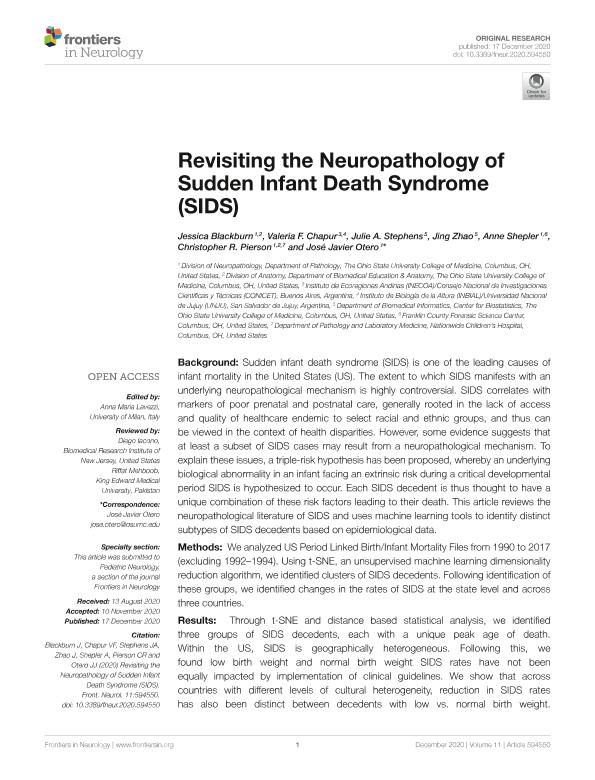Artículo
Revisiting the neuropathology of sudden infant death syndrome (SIDS)
Blackburn, Jessica; Chapur, Valeria Fernanda ; Stephens, Julie A.; Zhao, Jing; Shepler, Anne; Pierson, Christopher R.; Otero, José Javier
; Stephens, Julie A.; Zhao, Jing; Shepler, Anne; Pierson, Christopher R.; Otero, José Javier
 ; Stephens, Julie A.; Zhao, Jing; Shepler, Anne; Pierson, Christopher R.; Otero, José Javier
; Stephens, Julie A.; Zhao, Jing; Shepler, Anne; Pierson, Christopher R.; Otero, José Javier
Fecha de publicación:
12/2020
Editorial:
Frontiers Media
Revista:
Frontiers in Neurology
ISSN:
1664-2295
Idioma:
Inglés
Tipo de recurso:
Artículo publicado
Clasificación temática:
Resumen
Background: Sudden infant death syndrome (SIDS) is one of the leading causes of infant mortality in the United States (US). The extent to which SIDS manifests with an underlying neuropathological mechanism is highly controversial. SIDS correlates with markers of poor prenatal and postnatal care, generally rooted in the lack of access and quality of healthcare endemic to select racial and ethnic groups, and thus can be viewed in the context of health disparities. However, some evidence suggests that at least a subset of SIDS cases may result from a neuropathological mechanism. To explain these issues, a triple-risk hypothesis has been proposed, whereby an underlying biological abnormality in an infant facing an extrinsic risk during a critical developmental period SIDS is hypothesized to occur. Each SIDS decedent is thus thought to have a unique combination of these risk factors leading to their death. This article reviews the neuropathological literature of SIDS and uses machine learning tools to identify distinct subtypes of SIDS decedents based on epidemiological data. Methods: We analyzed US Period Linked Birth/Infant Mortality Files from 1990 to 2017 (excluding 1992–1994). Using t-SNE, an unsupervised machine learning dimensionality reduction algorithm, we identified clusters of SIDS decedents. Following identification of these groups, we identified changes in the rates of SIDS at the state level and across three countries. Results: Through t-SNE and distance based statistical analysis, we identified three groups of SIDS decedents, each with a unique peak age of death. Within the US, SIDS is geographically heterogeneous. Following this, we found low birth weight and normal birth weight SIDS rates have not been equally impacted by implementation of clinical guidelines. We show that across countries with different levels of cultural heterogeneity, reduction in SIDS rates has also been distinct between decedents with low vs. normal birth weight. Conclusions: Different epidemiological and extrinsic risk factors exist based on the three unique SIDS groups we identified with t-SNE and distance based statistical measurements. Clinical guidelines have not equally impacted the groups, and normal birth weight infants comprise more of the cases of SIDS even though low birth weight infants have a higher SIDS rate.
Archivos asociados
Licencia
Identificadores
Colecciones
Articulos(INECOA)
Articulos de INSTITUTO DE ECORREGIONES ANDINAS
Articulos de INSTITUTO DE ECORREGIONES ANDINAS
Citación
Blackburn, Jessica; Chapur, Valeria Fernanda; Stephens, Julie A.; Zhao, Jing; Shepler, Anne; et al.; Revisiting the neuropathology of sudden infant death syndrome (SIDS); Frontiers Media; Frontiers in Neurology; 11; 594550; 12-2020; 1-12
Compartir
Altmétricas



